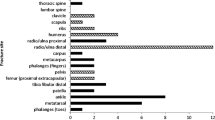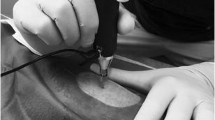Abstract
Summary
In a randomly selected cohort of Swiss community-dwelling elderly women prospectively followed up for 2.8 ± 0.6 years, clinical fractures were assessed twice yearly. Bone mineral density (BMD) measured at tibial diaphysis (T-DIA) and tibial epiphysis (T-EPI) using dual-energy X-ray absorptiometry (DXA) was shown to be a valid alternative to lumbar spine or hip BMD in predicting fractures.
Introduction
A study was carried out to determine whether BMD measurement at the distal tibia sites of T-EPI and T-DIA is predictive of clinical fracture risk.
Methods
In a predefined representative cohort of Swiss community-dwelling elderly women aged 70–80 years included in the prospective, multi-centre Swiss Evaluation of the Methods of Measurement of Osteoporotic Fracture risk (SEMOF) study, fracture risk profile was assessed and BMD measured at the lumbar spine (LS), hip (HIP) and tibia (T-DIA and T-EPI) using DXA. Thereafter, clinical fractures were reported in a bi-yearly questionnaire.
Results
During 1,786 women-years of follow-up, 68 clinical fragility fractures occurred in 61 women. Older age and previous fracture were identified as risk factors for the present fractures. A decrease of 1 standard deviation in BMD values yielded a 1.5-fold (HIP) to 1.8-fold (T-EPI) significant increase in clinical fragility fracture hazard ratio (adjusted for age and previous fracture). All measured sites had comparable performance for fracture prediction (area under the curve range from 0.63 [LS] to 0.68 [T-EPI]).
Conclusion
Fracture risk prediction with BMD measurements at T-DIA and T-EPI is a valid alternative to BMD measurements at LS or HIP for patients in whom these sites cannot be accessed for clinical, technical or practical reasons.
Similar content being viewed by others
References
International Society for Clinical Densitometry (ISCD) official positions 2007. Available at http://www.iscd.org/Visitors/positions/OfficialPositionsText.cfm. Accessed October 24, 2008
Casez JP, Troendle A, Lippuner K, Jaeger P (1994) Bone mineral density at distal tibia using dual-energy X-ray absorptiometry in normal women and in patients with vertebral osteoporosis or primary hyperparathyroidism. J Bone Miner Res 9(12):1851–1857
Zehnder Y, Lüthi M, Michel D et al (2004) Long-term changes in bone metabolism, bone mineral density, quantitative ultrasound parameters, and fracture incidence after spinal cord injury: a cross-sectional observational study in 100 paraplegic men. Osteoporos Int 15(3):180–189
Zehnder Y, Risi S, Michel D et al (2004) Prevention of bone loss in paraplegics over 2 years with alendronate. J Bone Miner Res 19(7):1067–1074
Krieg MA, Cornuz J, Ruffieux C (2003) Comparison of three bone ultrasounds for the discrimination of subjects with and without osteoporotic fractures among 7562 elderly women. J Bone Miner Res 18(7):1261–1266
Terwee CB, Mokkink LB, Steultjens MP, Dekker J (2006) Performance-based methods for measuring the physical function of patients with osteoarthritis of the hip or knee: a systematic review of measurement properties. Rheumatology (Oxford) 45(7):890–902
Looker AC, Wahner HW, Dunn WL et al (1995) Proximal femur bone mineral levels of US adults. Osteoporos Int 5(5):389–409
Looker AC, Orwoll ES, Johnston CC Jr et al (1997) Prevalence of low femoral bone density in older U.S. adults from NHANES III. J Bone Miner Res 12(11):1761–1768
Looker AC, Wahner HW, Dunn WL et al (1998) Updated data on proximal femur bone mineral levels of US adults. Osteoporos Int 8(5):468–489
Ruetsche AG, Kneubuehl R, Birkhaeuser MH, Lippuner K (2005) Cortical and trabecular bone mineral density in transsexuals after long-term cross-sex hormonal treatment: a cross-sectional study. Osteoporos Int 16(7):791–798
DeLong ER, DeLong DM, Clarke-Pearson DL (1988) Comparing the areas under two or more correlated receiver operating characteristic curves: a nonparametric approach. Biometrics 44(3):837–845
Marshall D, Johnell O, Wedel H (1996) Meta-analysis of how well measures of bone mineral density predict occurrence of osteoporotic fractures. BMJ 312(7041):1254–1259
Miller PD, Siris ES, Barrett-Connor E et al (2002) Prediction of fracture risk in postmenopausal white women with peripheral bone densitometry: evidence from the National Osteoporosis Risk Assessment. J Bone Miner Res 17(12):2222–2230
Stone KL, Seeley DG, Lui LY et al (2003) BMD at multiple sites and risk of fracture of multiple types: long-term results from the Study of Osteoporotic Fractures. J Bone Miner Res 18(11):1947–1954
Seeman E, Wahner HW, Offord KP, Kumar R, Johnson WJ, Riggs BL (1982) Differential effects of endocrine dysfunction on the axial and the appendicular skeleton. J Clin Invest 69(6):1302–1309
Silverberg SJ, Shane E, de la Cruz L et al (1989) Skeletal disease in primary hyperparathyroidism. J Bone Miner Res 4(3):283–291
Khosla S, Melton J 3rd (2002) Fracture risk in primary hyperparathyroidism. J Bone Miner Res 17(Suppl 2):N103–N107
Mottet JJ, Horber FF, Casez JP, Descoeudres C, Jaeger P (1996) Evidence for preservation of cortical bone mineral density in patients on continuous ambulatory peritoneal dialysis. J Bone Miner Res 11(1):96–104
Jaeger P, Lippuner K, Casez JP, Hess B, Ackermann D, Hug C (1994) Low bone mass in idiopathic renal stone formers: magnitude and significance. J Bone Miner Res 9(10):1525–1532
Leslie WD, Lix LM, Tsang JF, Caetano PA, Manitoba Bone Density Program (2007) Single-site vs multisite bone density measurement for fracture prediction. Arch Intern Med 167(15):1641–1647
Kanis JA, Oden A, Johnell O et al (2007) The use of clinical risk factors enhances the performance of BMD in the prediction of hip and osteoporotic fractures in men and women. Osteoporos Int 18(8):1033–1046
Acknowledgements
We are grateful to Dr. Philippe Kress for his invaluable contribution to the manuscript.
Conflicts of interest
None.
Author information
Authors and Affiliations
Corresponding author
Rights and permissions
About this article
Cite this article
Popp, A.W., Senn, C., Franta, O. et al. Tibial or hip BMD predict clinical fracture risk equally well: results from a prospective study in 700 elderly Swiss women. Osteoporos Int 20, 1393–1399 (2009). https://doi.org/10.1007/s00198-008-0808-7
Received:
Accepted:
Published:
Issue Date:
DOI: https://doi.org/10.1007/s00198-008-0808-7




